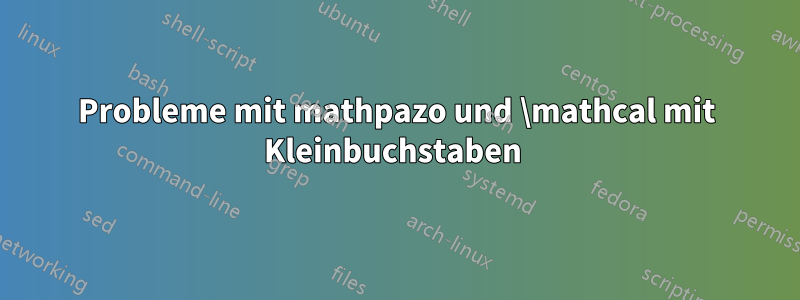
Ich versuche, die Schriftart mathpazo zu verwenden, habe aber Probleme, \mathcal mit kleinen Buchstaben zum Laufen zu bringen
das ist meine Vorlage
\documentclass[11pt]{amsart}
\usepackage{geometry} % See geometry.pdf to learn the layout options. There are lots.
\geometry{letterpaper} % ... or a4paper or a5paper or ...
%\geometry{landscape} % Activate for for rotated page geometry
%\usepackage[parfill]{parskip} % Activate to begin paragraphs with an empty line rather than an indent
\usepackage{graphicx}
\usepackage{amssymb}
\usepackage{epstopdf}
\usepackage{mathptmx}
\usepackage{accents}
\usepackage{amssymb}
\usepackage{amsfonts}
\usepackage{mathpazo}
\begin{document}
\maketitle
%\section{}
%\subsection{}
just some test $ \infty \mathcal{l}$
\end{document}
Antwort1
Die kalligrafischen Großbuchstaben werden der Schriftart zugeordnet cmsy10. Die Schriftart enthält nur kalligrafische Großbuchstaben.
Einfache TeX-Version zur Schriftartenprüfung
testfont.texEine Schriftart kann mithilfe von einfachen Formaten (nicht LaTeX) überprüft werden . LaTeX bietet nfssfont.tex, abgeleitet von testfont.tex, siehe nächsten Abschnitt.
Beispiel für eine interaktive Sitzung mit testfont:
$ pdftex testfont
This is pdfTeX, Version 3.1415926-2.5-1.40.14 (TeX Live 2013)
restricted \write18 enabled.
entering extended mode
([...]/texmf-dist/tex/plain/base/testfont.tex
Name of the font to test = cmsy10
Now type a test command (\help for help):)
*\help
\init switches to another font;
\end or \bye finishes the run;
\table prints the font layout in tabular format;
\text prints a sample text, assuming TeX text font conventions;
\sample combines \table and \text;
\mixture mixes a background character with a series of others;
\alternation interleaves a background character with a series;
\alphabet prints all lowercase letters within a given background;
\ALPHABET prints all uppercase letters within a given background;
\series prints a series of letters within a given background;
\lowers prints a comprehensive test of lowercase;
\uppers prints a comprehensive test of uppercase;
\digits prints a comprehensive test of numerals;
\math prints a comprehensive test of TeX math italic;
\names prints a text that mixes upper and lower case;
\punct prints a punctuation test;
\bigtest combines many of the above routines;
\help repeats this message;
and you can use ordinary TeX commands (e.g., to \input a file).
*\table
*\bye
[1{[...]/texmf-dist/fonts/map/pdftex/updmap/pdftex.map}]
<[...]/texmf-dist/fonts/type1/public/amsfonts/cm/cmr10.p
fb><[...]/texmf-dist/fonts/type1/public/amsfonts/cm/cmr7
.pfb><[...]/texmf-dist/fonts/type1/public/amsfonts/cm/cm
sy10.pfb><[...]/texmf-dist/fonts/type1/public/amsfonts/c
m/cmti10.pfb><[...]/texmf-dist/fonts/type1/public/amsfon
ts/cm/cmtt10.pfb>
Output written on testfont.pdf (1 page, 72843 bytes).
Transcript written on testfont.log.
Alternativ kann eine Treiberdatei für die nicht-interaktive Nutzung erstellt werden:
\let\noinit!
\input testfont
\def\fontname{cmsy10}
\startfont
\table
\bye
LaTeX-Version
\mathcalverwendet die mathematische Symbolschriftart (von fontmath.ltx):
\DeclareSymbolFontAlphabet{\mathcal}{symbols}
Das Paket mathpazoenthält die folgende Schriftdefinition für Symbole mit der Kodierung OMS:
\DeclareSymbolFont{symbols}{OMS}{zplm}{m}{n}
Die letzten vier Argumente sind die gleichen wie bei \usefontund werden für benötigt nfssfont.tex. Beispiel für eine interaktive Sitzung:
$ pdflatex nfssfont
This is pdfTeX, Version 3.1415926-2.5-1.40.14 (TeX Live 2013)
restricted \write18 enabled.
entering extended mode
([...]/texmf-dist/tex/latex/base/nfssfont.tex
LaTeX2e <2011/06/27>
Babel <3.9f> and hyphenation patterns for 77 languages loaded.
([...]/texmf-dist/tex/latex/base/article.cls
Document Class: article 2007/10/19 v1.4h Standard LaTeX document class
([...]/texmf-dist/tex/latex/base/size10.clo))
No auxiliary output files.
**********************************************
* NFSS font test program version <v2.2b>
*
* Follow the instructions
**********************************************
Input external font name, e.g., cmr10
(or <enter> for NFSS classification of font):
\currfontname=
*** NFSS classification ***
Font encoding [T1]:
\encoding=OMS
([...]/texmf-dist/tex/latex/base/omsenc.def)
Font family [cmr]:
\family=zplm
Font series [m]:
\series=m
Font shape [n]:
\shape=n
Font size [10pt]:
\size=
([...]/texmf-dist/tex/latex/psnfss/omszplm.fd)
Now type a test command (\help for help):)
*\table
*\bye
[1{[...]/texmf-dist/fonts/map/pdftex/updmap/pdftex.map}]
{[...]/texmf-dist/fonts/enc/dvips/base/8r.enc}
<[...]/texmf-dist/fonts/type1/public/amsfonts/cm/cmr10.pfb>
<[...]/texmf-dist/fonts/type1/public/amsfonts/cm/cmr7.pfb>
<[...]/texmf-dist/fonts/type1/public/amsfonts/cm/cmsy10.pfb>
<[...]/texmf-dist/fonts/type1/public/amsfonts/cm/cmti10.pfb>
<[...]/texmf-dist/fonts/type1/public/amsfonts/cm/cmtt10.pfb>
<[...]/texmf-dist/fonts/type1/public/mathpazo/fplmr.pfb>
<[...]/texmf-dist/fonts/type1/urw/palatino/uplr8a.pfb>
Output written on nfssfont.pdf (1 page, 88770 bytes).
Transcript written on nfssfont.log.
Die Treiberdatei für eine nicht-interaktive Sitzung kann wie folgt aussehen:
\let\noinit!
\input{nfssfont}
\def\encoding{OMS}
\usefont{OMS}{zplm}{m}{n}
\edef\currfontname{\fontname\font}
\startfont
\table
\bye
Zusammenfassung
Für „kalligrafische“ Kleinbuchstaben benötigen Sie eine andere Schriftart und können nicht verwenden \mathcal.




